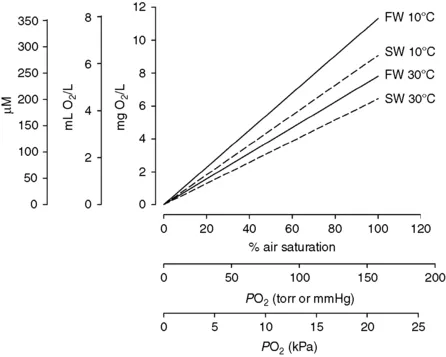
Fish Physiology: Hypoxia
- 517 pages
- English
- ePUB (mobile friendly)
- Available on iOS & Android
Fish Physiology: Hypoxia
About this book
Periods of environmental hypoxia (Low Oxygen Availability) are extremely common in aquatic systems due to both natural causes such as diurnal oscillations in algal respiration, seasonal flooding, stratification, under ice cover in lakes, and isolation of densely vegetated water bodies, as well as more recent anthropogenic causes (e.g. eutrophication). In view of this, it is perhaps not surprising that among all vertebrates, fish boast the largest number of hypoxia tolerant species; hypoxia has clearly played an important role in shaping the evolution of many unique adaptive strategies. These unique adaptive strategies either allow fish to maintain function at low oxygen levels, thus extending hypoxia tolerance limits, or permit them to defend against the metabolic consequences of oxygen levels that fall below a threshold where metabolic functions cannot be maintained.The aim of this volume is two-fold. First, this book will review and synthesize the adaptive behavioural, morphological, physiological, biochemical, and molecular strategies used by fish to survive hypoxia exposure and place them within an environmental and ecological context. Second, through the development of a synthesis chapter this book will serve as the cornerstone for directing future research into the effects of hypoxia exposures on fish physiology and biochemistry.- The only single volume available to provide an in-depth discussion of the adaptations and responses of fish to environmental hypoxia- Reviews and synthesizes the adaptive behavioural, morphological, physiological, biochemical, and molecular strategies used by fish to survive hypoxia exposure- Includes discussion of the evolutionary and ecological consequences of hypoxia exposure in fish
Frequently asked questions
- Essential is ideal for learners and professionals who enjoy exploring a wide range of subjects. Access the Essential Library with 800,000+ trusted titles and best-sellers across business, personal growth, and the humanities. Includes unlimited reading time and Standard Read Aloud voice.
- Complete: Perfect for advanced learners and researchers needing full, unrestricted access. Unlock 1.4M+ books across hundreds of subjects, including academic and specialized titles. The Complete Plan also includes advanced features like Premium Read Aloud and Research Assistant.
Please note we cannot support devices running on iOS 13 and Android 7 or earlier. Learn more about using the app.
Information
Chapter 1 The Hypoxic Environment
Robert J. Diaz and Denise L. Breitburg
Table of contents
- Cover image
- Table of Contents
- Preface
- Chapter 1 The Hypoxic Environment
- Chapter 2 Behavioral Responses and Ecological Consequences
- Chapter 3 Effects of Hypoxia on Fish Reproduction and Development
- Chapter 4 Oxygen and Capacity Limited Thermal Tolerance
- Chapter 5 Oxygen Sensing And The Hypoxic Ventilatory Response
- Chapter 6 Blood‐Gas Transport and Hemoglobin Function
- Chapter 7 Cardiovascular Function and Cardiac Metabolism
- Chapter 8 The Effects of Hypoxia On Growth and Digestion
- Chapter 9 The Anoxia-Tolerant Crucian Carp (Carassius Carassius L.)
- Chapter 10 Metabolic and Molecular Responses of Fish to Hypoxia
- Chapter 11 Defining Hypoxia
